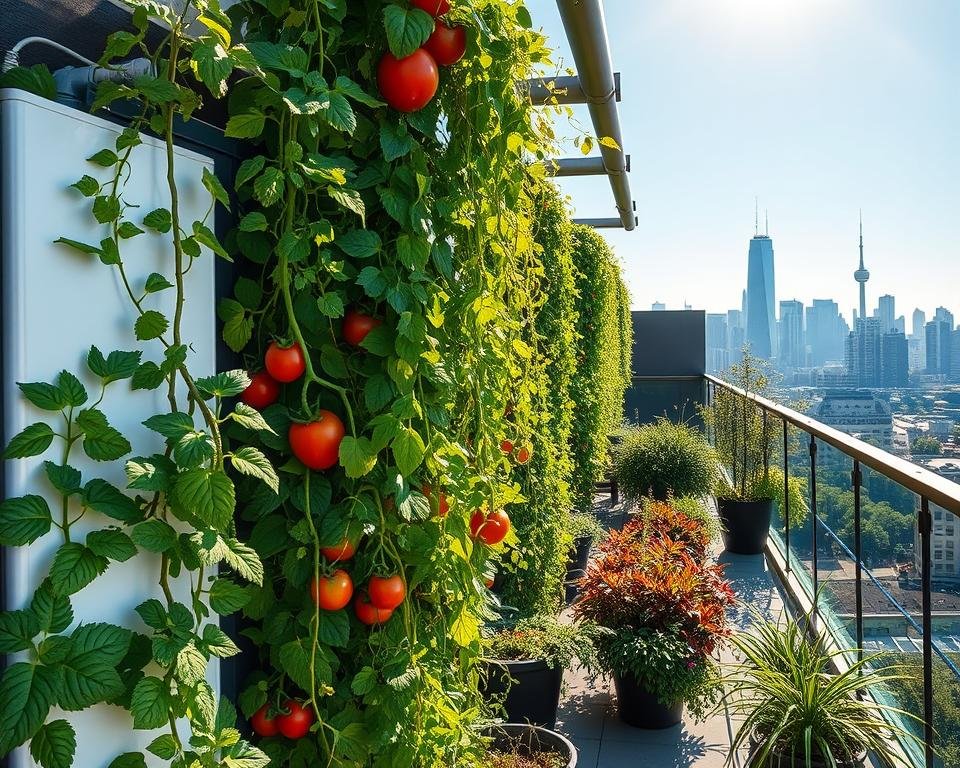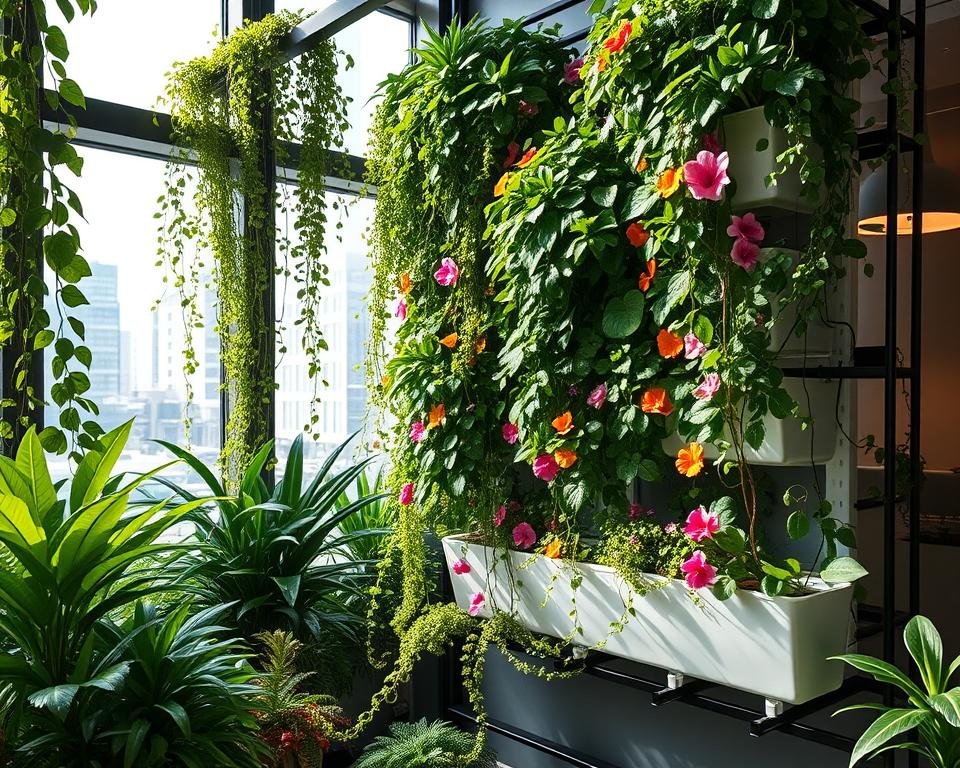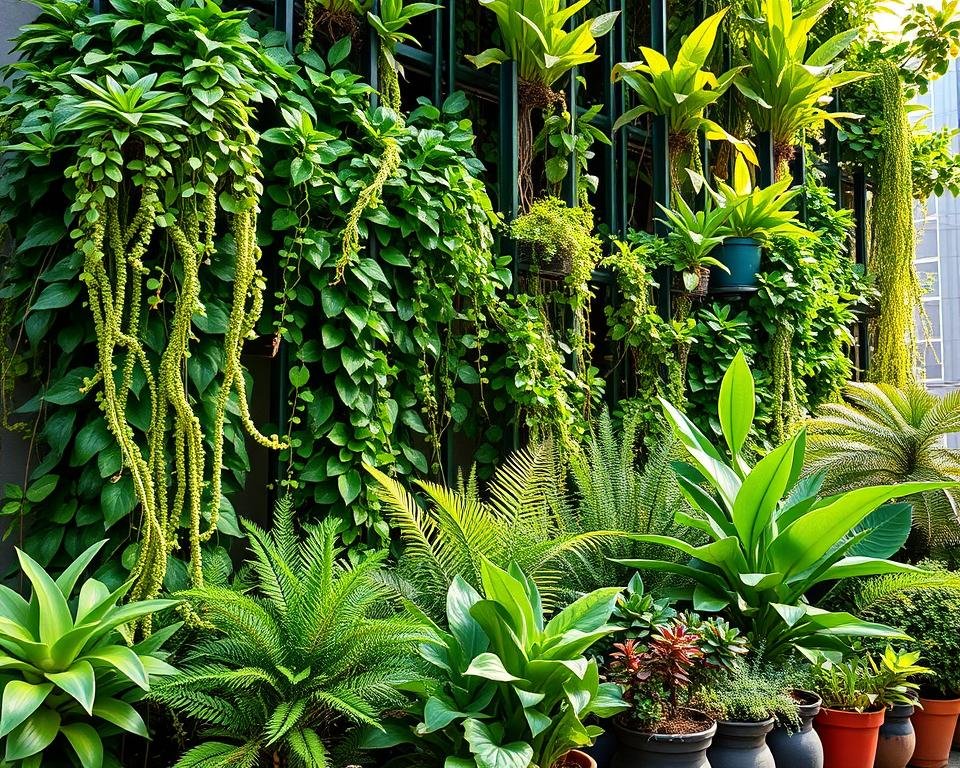Vertical Urban Gardening: Grow More in Less Space
The concrete jungle is changing. Cities are getting more crowded, and land for farming is running out. Urban gardening is a new way to grow food in the city. It turns empty walls or rooftops into green spaces that give us fresh food and make cities livelier.
Urban-gardening is more than just growing plants. It tackles big issues like hunger and harming the environment. With a third of the world’s land lost in 40 years, vertical farming is a smart choice. It needs 99% less land than regular farming and can grow up to 240 times more food.
Your city can turn into a green haven. Vertical gardens are not just pretty; they help build strong, self-sufficient communities. They use new ways to grow food, like rooftop gardens and community walls. This changes how we grow and get food in the city.
Key Takeaways
- Vertical gardens maximize food production in limited urban spaces
- Urban-gardening reduces environmental impact of traditional agriculture
- Innovative growing techniques can produce significant crop yields
- Vertical gardens improve urban air quality and community well-being
- Technology is making urban gardening more accessible and efficient
Understanding Vertical Gardening Systems
Urban spaces are changing with new vertical-garden solutions. These systems make the most of small areas. They are a green alternative to old farming ways.
Vertical gardening is a new way to farm in cities. It lets you grow more food in less space. These systems can make up to 75% more space for growing.
Hydroponic Growing Methods
Hydroponic vertical gardens don’t need soil. They use water full of nutrients to grow plants. This method has big advantages:
- Yields up to 10 times more produce per square foot
- Reduces water consumption by 90%
- Enables year-round crop production
- Minimizes pest risks without chemical interventions
Soil-Based Vertical Systems
Soil-based vertical systems are for those who like traditional gardening. They mix small growing spaces with old-school gardening. They work well in homes and businesses.
Controlled Environment Agriculture (CEA)
Controlled Environment Agriculture is the top tech in vertical gardening. NASA and USDA researchers are working on CEA to grow crops better in tough places.
Vertical farming isn’t just about growing food—it’s about reimagining agriculture for a sustainable urban future.
About 80% of city folks want to garden but lack space. Vertical-garden systems are a great way to live sustainably.
Essential Components for Successful Urban Growing
Urban-gardening turns small areas into green spots. You can grow herbs on a windowsill or have a rooftop garden. City farming needs smart planning and new ideas to use urban space well.
Starting your urban-gardening journey means picking the right tools and knowing what plants need. Here are key things for a successful city farm:
- Growing Containers: Pick light, flexible options like raised beds or vertical planters
- Soil Quality: Use a mix of 60% topsoil, 30% compost, and 10% organic stuff
- Water Management: Use drip irrigation to water plants well
- Lighting Solutions: Get grow lights for indoor or shady spots
Space is key in urban-gardening. Raised beds are great because they:
- Help water drain better
- Prevent soil from getting too hard
- Let you adjust height for easy reach
- Are the right size (3-4 feet) for easy care
“Urban agriculture is not just about growing food, it’s about growing communities” – Urban Farming Expert
Technology has changed urban-gardening, making it easier than before. Smart tools, self-watering systems, and hydroponics help you grow more with less space and work.
Environmental Benefits of Urban Gardening
Urban-gardening is a key solution to many environmental problems in cities. It turns unused spaces into green areas. This helps with sustainability and local food production, making a big environmental difference.

Urban agriculture has many benefits beyond just growing food. It brings green spaces to cities, tackling big ecological issues.
Improved Air Quality and Heat Reduction
Urban gardens help fight the urban heat island effect. They can lower temperatures by several degrees during hot spells. Your vertical-garden acts as a natural cooler, cutting down energy use and improving air quality.
- Reduces urban temperatures by up to 3-4 degrees
- Filters atmospheric pollutants
- Creates natural cooling zones
Water Conservation Advantages
Techniques like hydroponics change how we use water in farming. They can cut water use by up to 90% compared to old farming ways. This makes them a green choice for growing local food.
| Farming Method | Water Usage | Efficiency |
|---|---|---|
| Traditional Agriculture | High Water Consumption | Low |
| Hydroponic Urban Farming | Minimal Water Usage | High |
Carbon Footprint Reduction
Urban-gardening cuts down on carbon emissions from food transport. Growing food close to where it’s eaten can reduce carbon footprints by 50% or more.
“Urban gardens are not just about growing food—they’re about growing a sustainable future.” – Environmental Researcher
Your urban garden is more than a hobby. It’s a vital part of making cities sustainable and resilient.
Space-Saving Solutions for City Dwellers

Urban gardening has changed how city folks grow plants in tight spots. Your vertical garden can turn a small balcony or indoor spot into a lush green haven. Now, you can grow fresh food and lovely plants without needing lots of land.
“In urban environments, every square inch counts – and vertical gardening is the ultimate solution for maximizing green potential.” – Urban Gardening Expert
Vertical gardening uses up space, which is key in cities where room is scarce. Here are some smart ways to save space:
- Hanging wall planters for compact herb gardens
- Modular shelving systems with integrated growing trays
- Stackable container gardens for balconies
- Window box installations for edible and ornamental plants
Did you know vertical gardens can boost property value by 5-15%? These green solutions not only save space but also make your home better. City folks can turn small outdoor spots into green, productive areas with smart vertical gardening.
Your urban gardening adventure can begin with easy, flexible systems that need little care. With the right strategy, you’ll make a lively green space that gives you fresh herbs, veggies, and plants. All this, right in the heart of the city.
Plant Selection and Growing Techniques
Urban gardening turns small areas into green oases. Your vertical garden can be a source of fresh local food with the right plants and care. Whether it’s a balcony, rooftop, or tiny backyard, knowing which plants to choose and how to care for them is key.

Best Plants for Vertical Gardens
Choosing the right plants is essential for a successful urban garden. Here are some top picks:
- Herbs: Basil, mint, and cilantro
- Leafy Greens: Lettuce, spinach, and kale
- Compact Vegetables: Cherry tomatoes, peppers, and radishes
- Succulents: Great for easy, decorative spaces
“Success in urban gardening is about choosing plants that thrive in limited spaces and controlled environments.” – Urban Gardening Expert
Seasonal Growing Strategies
Urban gardening can produce food all year with the right planning. Here are seasonal tips:
- Spring: Plant cool-weather crops like lettuce and peas
- Summer: Focus on heat-loving vegetables like tomatoes
- Fall: Transition to root vegetables and hardy greens
- Winter: Use indoor growing techniques or heated greenhouses
Maintenance Requirements
Keeping your urban garden healthy needs regular care. Important maintenance steps include:
- Regular watering: Use drip irrigation systems for efficiency
- Organic pest control methods
- Monthly soil nutrition checks
- Pruning and plant rotation
By following these tips, you can make your urban garden vibrant and productive. It will give you fresh local food while using every inch of space.
Innovative Urban Farming Technologies
City farming is getting a tech boost, changing how we grow food in cities. New tech makes it easier to produce fresh food, even in small spaces. This is a big step towards a more sustainable future.
Modern urban farming uses advanced tech to make the most of little space and resources. These new methods are changing how we grow food in cities.
Key Technological Innovations
- Hydroponic Systems: Grow crops without soil, using nutrient-rich water solutions
- Aeroponic Technologies: Cultivate plants in misted environments with minimal water usage
- Smart Monitoring Platforms: Utilize AI and IoT for precise crop management
- LED Grow Lights: Enable year-round production independent of natural sunlight
These technologies bring big benefits for city farming. For example, vertical farming can produce 20 times more yield per square foot than traditional farming.
| Technology | Water Efficiency | Yield Improvement |
|---|---|---|
| Hydroponics | 90% Less Water | 30-50% Faster Crop Growth |
| Aeroponics | 95% Less Water | Up to 40% Higher Yields |
| Vertical Farming | 80% Water Conservation | 20x More Produce Per Acre |
“Technology is transforming urban agriculture from a niche practice to a scalable solution for sustainable food production.” – Urban Agriculture Research Institute
As cities grow, these tech solutions are key for local food security. They also help cut down on transportation costs and environmental harm.
Building Community Through Urban Gardens
Urban gardens are changing city views, linking people to their food sources. City farming builds strong, united communities through farming together.
Community gardens are great for bringing people together and growing food. In Denver, these gardens have made a big difference:
- Denver Urban Gardens (DUG) manages 200 garden sites across the Metro Denver area
- Community gardens improve nutrition and physical health
- Urban gardening offers learning chances for everyone
Local Food Production Strategies
Urban gardens meet important community needs. The Urban Agriculture Resilience Program helps, funding 106 projects with grants from $5,000 to $20,000.
Educational Opportunities
Urban gardens teach about green farming, healthy eating, and teamwork. Food forests are special places for learning about growing food and nature.
Social Impact
“Urban gardening can save $25 for every $1 spent, indicating a 2500% return on investment.” – George Ball, Burpee Seeds Chairman
City farming does more than grow food. It brings people together, boosts health, and helps share skills in diverse groups.
Joining urban gardening efforts makes cities better, greener, and stronger.
Conclusion
Urban gardening is a strong solution to many city problems. It turns small areas into green spaces that help with food and the environment. Even though it currently produces more CO2 than traditional farming, it has a lot of room for improvement.
Getting involved in urban gardening can really help. Out of 73 gardens studied, 17 were better for the climate. Every little bit helps in making cities greener. Plus, urban trees and plants clean the air and make food right in your community.
Sustainability is good for the planet and the economy. Urban farming creates jobs, supports local businesses, and brings people together. Using new methods like vertical gardening and hydroponics can cut down on carbon emissions and make food systems stronger.
The future of urban gardening looks promising. As cities grow and face more environmental issues, your efforts can make a big difference. Start small, keep learning, and watch your garden change your area and maybe even the whole community.







